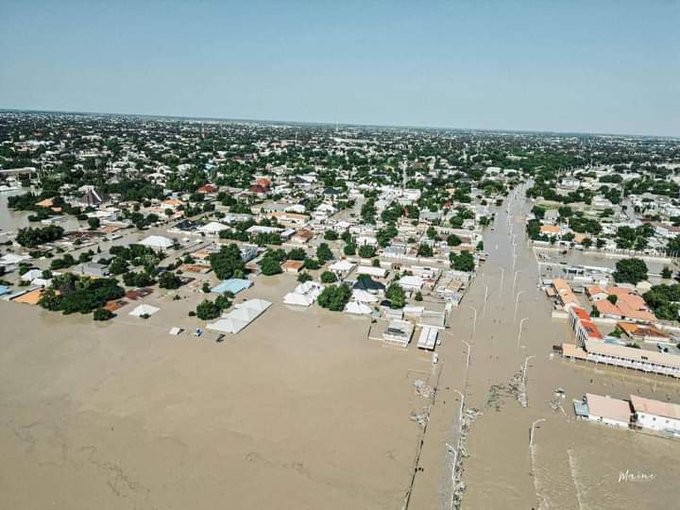Today I suspend the continuation of the piece I started last week to enable this page to commiserate with the people of Maiduguri who are undergoing the worst tribulations of all time. The flood that swept through the city overnight last week, Tuesday, as a result of the overflow of Alau Dam, caught both citizens and their government in their sleep by surprise. The citizens were caught by surprise because they were lulled by a pronouncement of a powerful government team that went to assess the stability of the dam. After inspecting the structure, the government team made assurances that nothing untoward would happen to the city and that all measures were in place in case of eventualities.
Contrary to this exhortation, the dam burst, and half of the city was ravaged by a bewildering fury of water, an experience of an Armageddon scale – the water sweeping everything in its path, people, livestock, houses, and vehicles. The extent of the devastation is incredulous. Those who know Maiduguri would find it difficult to believe that the three service bridges at Lagos Street, Gwange and Custom, conjoining parts of the town were all submerged.
The flood rode its way to inundate all the low-lying areas surrounding the length of the river, taking its toll on many landmarks of the city, including Monday Market, Musa Usman Secretariat, the General Hospital, Shehu’s Palace, Gamboru Market, the Maiduguri Teaching Hospital, old and new prisons, state low-cost buildings and hundreds of thousands of citizens still in bed that Tuesday night. In its murderous journey, the flood did not even spare the graveyard where our grandparents, parents and siblings are reposing in peace.
Despite the quick upsurge of the flood, the response to it was however magnificent. Rescue teams by state officials were on the ground covering the nooks and crannies of the city getting the citizens out of this dire predicament. Vice President Kashim Shettima, Governor Babagana Umara Zulum and Senator Kaka Shehu Lawan gave exemplary leadership to the rescue efforts. The picture of Kashim Shettima wading through flood water, waist-deep, in the Shehu’s palace would remain etched in many minds for years.
Maiduguri is a fairly young city of a little over a hundred years old. I was born and raised there, in the mid-1950s. I also spent the bulk of my public service career there, firstly in the Chad Basin Development Authority (CBDA) that built the Alau Dam and later as a functionary in the Borno State government. People of my age group have never experienced flooding of that scale. Only the smaller river, Ngadabul, occasionally burst its banks to storm the area around the school of nursing and the zoo. The Ngadda River was never a threat to the city as it snaked its way to Jere where its flood water had enriched the soil for ages to make it productive for rice cultivation.
The Alau Dam was earlier conceived in the 1970s as a structure to control the flow of water to Jere Bowl for increased rice production. It was only in the early 1980s that the idea shifted to using the dam for Maiduguri water supply. Due to persistent drought in the 1970s, underground water in Maiduguri had depleted considerably, making surface water supply the only panacea—the CBDA General Manager of the time, Eng. Bunu Sheriff Musa, made it a priority project and sourced funds by raising a bank loan to build the dam, hoping that payments for water supply from the Borno State government would offset the loan and also pay for the regular maintenance of the structure.
Work started on the dam site in 1984 and when Bunu Sheriff became a minister of the federal republic in 1985, his successors, Mai Mohammed Jir and Eng. Baba Gana Zanna, ensured its completion by 1990. Payment for water supply ultimately became a sore point between CBDA and the state government and was never satisfactorily resolved. In the later years, the federal government had to offset the loan when it was becoming too much of a burden for CBDA to handle. Nevertheless, the issue of maintaining the dam remained pertinent, and finding funds for that purpose would remain central to the problem of keeping the dam safe.
It is an intriguing turn of events now that the water has come flooding over Alau Dam exactly 30 years after. I recall leaving Maiduguri on September 13, 1994 to attend to some official matters in Abuja. The next morning in Abuja I was shocked to learn that Maiduguri was under water. I was taking the news in my stride but when I heard that the flood water had reached the Shehu’s Palace, a central place in Maiduguri, I left everything and rushed back home. On reaching Maiduguri the devastation I found was profound even for that scale.
Now 30 years on we are still caught in the same vortex. Maybe we have to tell ourselves that Alau Dam is no more in its prime, after close to 40 years of service. Maiduguri has survived again but the pains and the loss have multiplied over what was experienced in 1994. For Maiduguri to survive a similar onslaught, a lot of soul-searching has to be undertaken to establish how to fund the maintenance of Alau Dam.

 Join Daily Trust WhatsApp Community For Quick Access To News and Happenings Around You.
Join Daily Trust WhatsApp Community For Quick Access To News and Happenings Around You.


